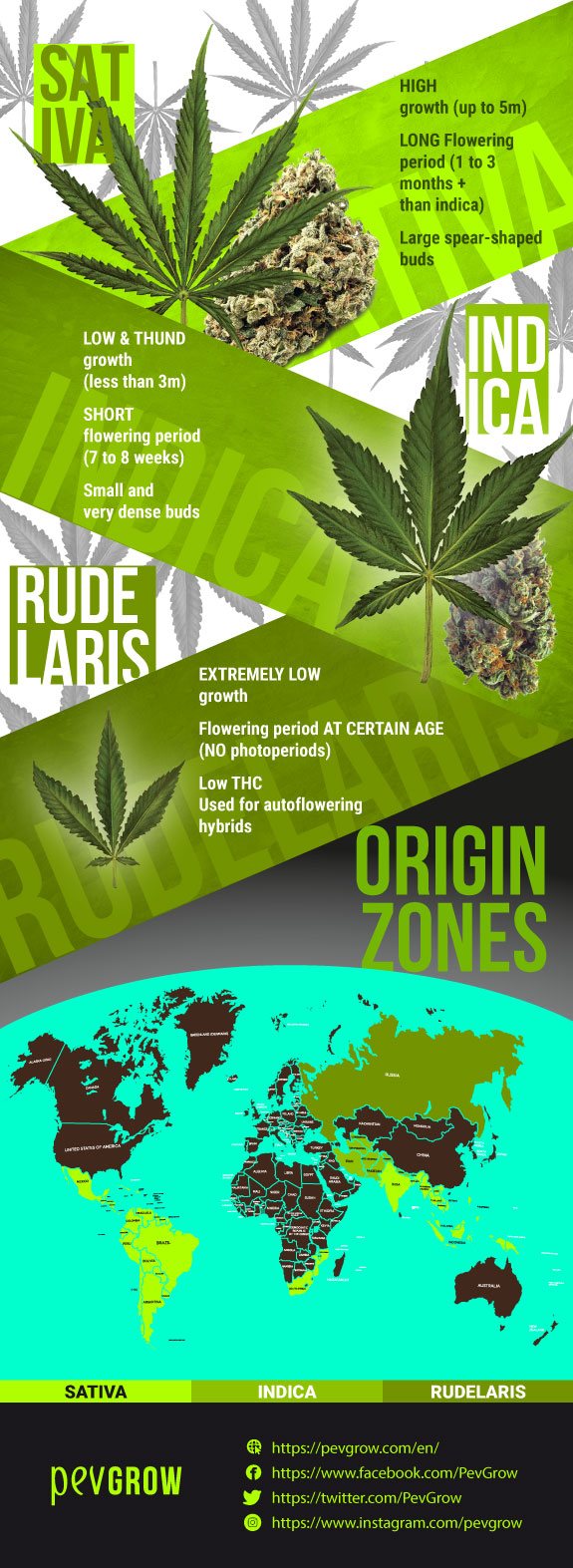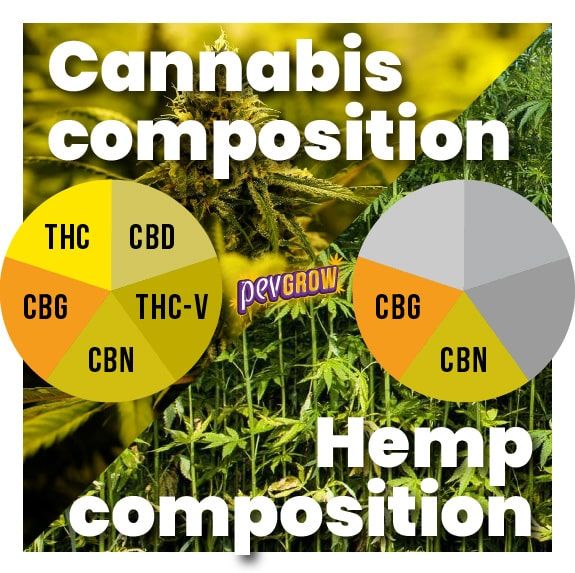

In constant struggle for the regulation of cannabis, mainly in the medicinal field.
07-06-2019 11:00:39 - Updated: 7 June, 2019
Cannabis and hemp are two terms that have often been used indistinctly in the past and, although there is a direct connection between both of them, there is a separation between the two types of species in the Cannabis gender.
To first understand the difference between hemp and cannabis, we must look at its scientific classification of the marijuana we know today. Its family is Cannabaceae and its genus is Cannabis. Next, the species found within Cannabis are Cannabis sativa, Cannabis indica, and Cannabis ruderalis. The first two are well known within the cannabis community, but Cannabis ruderalis is less understood.
✨ The three families of Cannabis
Cannabis sativa
The biological features of Cannabis sativa are many: tall growing, long flowering, suited for warmer climates, and distinguishable leaf size. These features make sativa plants challenging to miss because they are in contrast to the biological features found in Cannabis indica.
Cannabis sativa is capable of growing up to 5 meters and on due to the competition found in their natural environments. In tropical latitudes, plants grow vertically because they’re in constant competition with other plants to reach the sunlight.
Sativa varieties are accustomed to long flowering periods due to their season with more extended periods of daylight (summer). These periods last longer than colder climates; therefore the flowering process of sativa plants take 1-3 months longer than their indica counterparts.
Sativa plants originated from regions such as Malawi, Mozambique, South Africa, Southern India, Central/South America, and from the vast tropics of South East Asia. Sativa plants thrived in these wet and humid environments. Due to their origins, sativa plants have a high tolerance for heat and humidity.
Aside from their tall stature, the leaves found on Cannabis sativa varieties are easy to spot. The “fingers” on the leaf are many, usually 9-12, and extremely thin with a defined razor edge. The buds found on sativa varieties tend to be large and spear-like.
Cannabis indica
The biological features found in Cannabis indica are generally the opposite found in sativa. They are squat and bushy, short flowering, suited for colder climates, and have a broader leaf structure. Over countless years of adaptation, Cannabis indica has managed to spread across the globe with ease.
Cannabis indica usually is short in stature, and grow bushy rather than in the Christmas tree shape found in sativa. Indica plants typically don’t grow larger than 3 meters but do spread out. Since indica plants are not desperately fighting their neighbors for sunlight, they’re allowed to become wider than tall.
Indica plants usually flower in 7-8 weeks because of the shorter summer sunlight and because of the impending fall season. Indica plants have been forced to adapt to a short growing season; therefore they flower much faster than sativas.
Cannabis indica originated in Pakistan, Northern India, Afghanistan, Uzbekistan, Tibet, and other temperate zones throughout the world. These regions are mountainous or deserts, with frigid winters and an overall harsh environment. This makes most indica varieties drought tolerant, adapted to lower temperatures and fast flowering.
The leaves found on indica varieties tend to have less “fingers” and are generally wider than sativa. The buds that grow on indica plants are usually small and extremely dense.
Cannabis ruderalis
Cannabis ruderalis is not well understood by the cannabis community. The reason is that ruderalis doesn’t produce much THC, grows extremely small, and is prone to flowering at a certain age rather than through photoperiods like indica and sativa.
Mainly found in countries such as Russia and Siberia, these plants are used to mild conditions during the summer. Ruderalis plants are treated more like weeds due to their insignificant amounts of THC.
You’ll be surprised to find out that autoflowering cannabis strains are hybrids based on ruderalis plants. Breeders have used Cannabis ruderalis for its unique characteristic of autoflowering to introduce into their own hybrids to increase bud production and THC content.

⭐ Cannabis
Cannabis Composition
Cannabis sativa and Cannabis indica are both composed of THC, CBD, THC-V, CBN, and CBG. Almost everyone will recognize THC and CBD, but the other compounds are less known.
Sativa and indica varieties produce flowers with a THC content ranging between 10 and 30%, but in their composition of CBD, with the exception of the last cannabis seeds with high CBD content created by seed banks, hemp naturally has a higher percentage of cannabidiol..
There are other compounds that are in indica and sativa plants in greater proportion than their cousin the hemp, as the terpenes are. Terpenes play an important role in the taste that floods our palate, the smell that invades the room and the general effect we experience.
Cannabis Uses
We can separate the use of cannabis into two categories: medicinal, recreational, and spiritual. Humans have been using marijuana plants for one of these three reasons for thousands of years, and we continue to do so up to this very day.
- Marijuana has proven medical benefits in regards to cancer treatment, PTSD, bipolar disorder, asthma, insomnia, Alzheimer’s disease, Crohn’s disease, multiple sclerosis, chronic pain, and many others. Countless clinical trials have shown that cannabis from indica and sativa varieties work at varying levels, depending on the amounts of THC and CBD.
- On a recreational level, we enjoy getting high. This is why the recreational side of cannabis is such a booming business. Many of us use weed after a long day or with a group of friends- we use it because we enjoy it. Few countries allow the recreational use of marijuana, but awareness is growing, and the potential for the better understanding of cannabis is on the horizon.
- People also use marijuana for spiritual reasons. This can be seen from cultures from past to present. Either through cultural practices or personal beliefs, cannabis has played significant roles in spirituality.
Cannabis Products
The end product of cannabis comes in many different forms. Concentrates, flowers, hash, edibles, and vaporizers are all part of the product offering from marijuana plants. These are all produced from either Cannabis sativa or Cannabis indica.
- Concentrates are routinely testing at 50-99% THC depending on the starting material and method used. Concentrates come in the form of shatter, distillate, crumble, oil or rosin.
- Flowers are the buds harvested from a mature cannabis plant. Buds are covered with sticky trichomes that are filled with THC and range between 10-30% THC. Buds are actually a female Cannabis indica or sativa’s natural function of growing a multitude of pistils in search of male pollen. Since we want large buds, we keep males from pollinating females to allow the female to continue its search; thus getting larger.
- Edibles are a method by which we infuse food with cannabis products, such as cannabutter or concentrate. This method allows us to ingest cannabis rather than smoking it.
- Vaping marijuana is a new use case for cannabis thanks to technological breakthroughs in the industry. Vape pens are loaded with concentrate to allow us to smoke without the carcinogenic effect found through combustion.
Legality
Many countries still outright ban the use and sale of any cannabis product. Few countries allow their citizens to use cannabis legally, but they are few and far between. The reason many states still ban marijuana is that they deem it an intoxicant because of its high THC content.
Countries that either allow or partially allow cannabis are the United States, Canada, Spain, the Netherlands, Peru, Uruguay, and South Africa. Legalization has become a hot topic in many countries, so this list is expected to rise shortly.
⛳ Hemp
It may sound confusing at first, but hemp is actually a subspecies of Cannabis sativa. The significant difference that separates hemp (C. Sativa ssp. sativa) from Cannabis sativa is how it’s been bred over the years for specific qualities.
Hemp can be identified by its extremely tall stature, long and thin leaves, and thick stalk at maturity. Considering that it’s a subspecies of Cannabis sativa, it too carries the qualities of sativa varieties.
Hemp plants have a similar growth pattern to indica and sativa varieties, where it generally takes 4 months to reach full maturity. The buds found on hemp are very similar to those of sativa variety, which can be described and long and spear-like. Son origine le rend suffisamment tolérant à la chaleur et capable de résister à l’humidité. Hemp’s origins are that of Cannabis sativa, thus making it adequately heat tolerant and capable of withstanding humid and wet conditions.
Hemp Composition
This is where hemp plants and cannabis really differ. Hemp has been bred to be void of any THC or CBD content. The difference between hemp and marijuana is that hemp does not have any psychoactive chemicals. Since hemp does not have THC, it has a broader acceptance from governments across the globe.
Agricultural engineers have carefully eliminated the traits commonly found in today’s hemp varieties. By selective breeding, hemp has been grown with THC levels of less than 0.2%.
Hemp Uses & Products
- Since the difference between hemp and cannabis is that of its THC and CBD content, hemp has an extensive range of use cases. The primary use case for hemp is for fiber production. Other use cases are paper production, building materials, jewelry, cordage, plastics, and biofuels. Growing hemp in place of the destruction of forests for raw materials is the ethical choice, and a growing number of countries are beginning to realize this.
- The growing demand for alternative fuels has boosted lobbyists in the hemp industry. Hemp has been documented to produce far more biofuel in less space than competing industries. The near future can see a significant boom in hemp-based biofuel production facilities.
- Hemp is also grown as a weed recipes. Hemp farms allow male plants to pollinate female hemp plants for the sole purpose of harvesting their seeds. Hemp seeds have become popular in foodie culture due to its exoticness and health benefits.
- Hemp seeds naturally contain high amounts of protein, making them ideal for protein manufactures. The leaves of hemp are edible and are becoming increasingly commonplace in health food stores. Oil producers have begun to make hemp oil due to its unusually high level of unsaturated fats.
Legality
So far, the United States, France, Australia, Canada, Russia, Ukraine, the United Kingdom, and 23 other countries allow the production of industrial hemp. This is in stark contrast to the legality faced by cannabis. Hemp is increasingly becoming the eco-friendly material to produce paper, textiles, and other materials. Its high nutritional value has also created awareness of its health benefits.
In the past, hemp was outlawed the same as cannabis because regulators did not understand the difference between the two plants. Where cannabis plays an integral role through its THC and CBD content, hemp plays its role in the production of raw goods and food.

✅ Hemp vs. Marijuana
Although people usually mistake each other for their obvious morphological similarities, hemp and marijuana are two different varieties of cannabis. Its main difference is in its chemical composition and its THC levels (psychoactive compound of the cannabis). In the hemp plant the concentration of THC is minimum (below 2%), whereas in marijuana crops these levels exceed 5%.
On the contrary, hemp has concentrations of CBD (cannabidiol) more elevated than marijuana. This compound does not have psychotropic effects, but very good properties to elaborate products of human consumption that are beneficial for health.
Visually, hemp has thinner leaves that are less dense. The stem is higher and thinner than those of cannabis and is easier to cultivate, since its development is optimal in diverse climates and more adverse conditions.

🎬 Historical evolution of hemp
It is said that hemp has been present in the evolution of humanity from year 10,000 B.C. Its origins come from the Middle East (South Asia) where clothes and pieces of crafts have been discovered in several regions that contained hemp and that go back to 8,000 B.C. Many historical records from ancient China show that hemp seeds and hemp oil were used as food sources.
Later in the year 4,000 BC the hemp was used to make different fabrics and shape the ropes in the arches of soldiers in China. Egyptian Gods like Seshat (Goddess of the writing and history) were represented by the old Egyptians in 2,800 BC with what seemed a hemp leaf above its head.
It was not until the beginning of century XX when other materials arose for the invention of fibers to elaborate fabrics when the hemp lost popularity. With the appearance of the new laws that prohibited the use and culture of marijuana, the production of hemp also was affected. Nevertheless, with the advances in scientific investigations, and the current flexibilizations in many countries with the laws applied to cannabis, it is possible to be said that the potentialities of this plant have been rediscovered.
👌 Conclusion
Now you understand the main differences between hemp and cannabis. Both hemp and marijuana play an essential part in our lives, whether through the THC content of cannabis or through hemp-related food.
It’s important to note the differences in the use of cannabis and hemp because it furthers the global understanding of these two plants. It’s our responsibility to have a clear understanding of these two plants that have provided us with rich experiences. It’s also imperative to understand that hemp is actually a subspecies of Cannabis sativa.
This is an essential factor to realize because it shows the broad implication that all forms of Cannabis have nearly the same capability as industrial hemp. By knowledge and understanding, we may soon see a time where cannabis is viewed in the same lens as industrial hemp.





